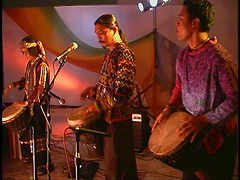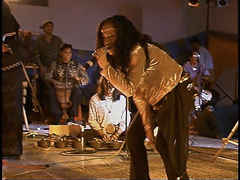Pinikpikan
 It all started 1989 at the first Baguio Arts Festival. Baguio City, located in the Cordillera Mountains of the Northern Philippines, is the home to many of the most renowned contemporary Filipino artists. After the Festival´s opening, participating artists from Manila and the provinces had joined up with members of the Baguio Arts Guild for a dinner at the Cafe by the Ruins, Baguio´s homegrown cultural center. As they sat around the Café´s "dap-ay" (a circular rock installation found in the tribal villages of the Cordillera where elders hold their council and male initiation rites), someone picked up a couple of pieces of pinewood meant for the fire raging at the centre. Another picked up some bamboo segments. Rum and beer bottles were used. So were covers of pots and pans. Rocks were pounded. Sticks flailed. A rhythm was born influenced by the traditional beats of the surrounding indigenous Igorots. The well known rock band The Blank joined in with lead and bass guitars. A keyboard was set up. Saxophones and flutes appeared. Grace Nono, the lead singer of The Blank wailed. The indigenous Bisaya and Ilonggo contingents from the southern islands of the Philippines connected with their melodies. The music was called "Rock ‘n´ Runo" (a reed found in the highlands similar to thin bamboo) as opposed to rock ‘n´ roll. Visual artist and founding member of the Baguio arts Guild, Manong BenCab named it PINIKPIKAN, after a Mountain Province chicken dish in which the native chicken is prepared with a "rhythm" stick before it is cooked.
It all started 1989 at the first Baguio Arts Festival. Baguio City, located in the Cordillera Mountains of the Northern Philippines, is the home to many of the most renowned contemporary Filipino artists. After the Festival´s opening, participating artists from Manila and the provinces had joined up with members of the Baguio Arts Guild for a dinner at the Cafe by the Ruins, Baguio´s homegrown cultural center. As they sat around the Café´s "dap-ay" (a circular rock installation found in the tribal villages of the Cordillera where elders hold their council and male initiation rites), someone picked up a couple of pieces of pinewood meant for the fire raging at the centre. Another picked up some bamboo segments. Rum and beer bottles were used. So were covers of pots and pans. Rocks were pounded. Sticks flailed. A rhythm was born influenced by the traditional beats of the surrounding indigenous Igorots. The well known rock band The Blank joined in with lead and bass guitars. A keyboard was set up. Saxophones and flutes appeared. Grace Nono, the lead singer of The Blank wailed. The indigenous Bisaya and Ilonggo contingents from the southern islands of the Philippines connected with their melodies. The music was called "Rock ‘n´ Runo" (a reed found in the highlands similar to thin bamboo) as opposed to rock ‘n´ roll. Visual artist and founding member of the Baguio arts Guild, Manong BenCab named it PINIKPIKAN, after a Mountain Province chicken dish in which the native chicken is prepared with a "rhythm" stick before it is cooked.  The PINIKPIKAN band was never ever "officially" formed. Yet it exists. It also engages itself in the OPM Movement (Original Filipino Music to protect the interests of the musicians), The Humanist Movement and The Peace Movement. Diokno Pasilan calls the concept a "collaborative idea for artists who consider it a lifestyle based on an intuitive notion of coming together and sharing the moment with the creative impulses of music and art according to the participants' own understanding." Interactive, as one would say these days. An art Interface through musical rhythms.
The PINIKPIKAN band was never ever "officially" formed. Yet it exists. It also engages itself in the OPM Movement (Original Filipino Music to protect the interests of the musicians), The Humanist Movement and The Peace Movement. Diokno Pasilan calls the concept a "collaborative idea for artists who consider it a lifestyle based on an intuitive notion of coming together and sharing the moment with the creative impulses of music and art according to the participants' own understanding." Interactive, as one would say these days. An art Interface through musical rhythms. One of the unusual characteristics of this "band" is that the participants aren't all career musicians. Most are visual artists, installationists, filmmakers. And one or two even consider themselves as Art Objects. The "best" music the group has ever put together was created at parties or simlar occasions. This is because of the spontaneous, trance-like celebratory aspect of the participants' lifestyles.
From a Baguio cafè´s dap-ay to a living room on Protacio in Pasay in Manila, from the beaches of Palawan to the mountains of Sagada, the music has incessantly rocked and rolled. Different places, different groupings, but always the percussion and the jamming. The members have never been the same yet the members are…
 Pinikpikan is a band of skin drummers, wailers, rock guitarists, and dancers unified not only by primal sound but also by bohemian logic. A decade or so in history, Pinikpikan has in essence been led and/ or influenced by a patrilineal succession of charismatic personalities starting with the two late Pepito Bosch, whose grandfather exported granit stones from Germany to Asia, and Roberto Villanueva. Others were BenCab, Boyu, Diokno Pasilan, and Billy Bonnevie. Finally, setting the weave in its sound comes rock veteran Sammy Asuncion.
Pinikpikan is a band of skin drummers, wailers, rock guitarists, and dancers unified not only by primal sound but also by bohemian logic. A decade or so in history, Pinikpikan has in essence been led and/ or influenced by a patrilineal succession of charismatic personalities starting with the two late Pepito Bosch, whose grandfather exported granit stones from Germany to Asia, and Roberto Villanueva. Others were BenCab, Boyu, Diokno Pasilan, and Billy Bonnevie. Finally, setting the weave in its sound comes rock veteran Sammy Asuncion. Members have come and gone. They still do. A streamlining of sorts-yet forever crossing the boundaries of space-from mountains, beaches, and artists´ enclaves, to concert halls and videos. And still the banging on rocks - the summoning of the muses. Through flights and bungee-dives, PINIKPIKAN continues to trans-resurrect itself, drawing from its participants´ music from the files in their bellies.
In 2000, PINIKPIKAN has earned acclaim for winning Five Awards from the prestigious KATHA Organization of Filipino composers, for its second album offering entitled, "ATAS". ATAS means Mission, a mission of love and perseverance. The Awards were for: Best World Song and Best World Performance for "Kalipay", Best Instrumental Performance for "Singkilan, Best World Album, and last BUT most, the Best Album of the Year. This is not to mention that two other tunes, "Kahimanawari" and "Ani-Wana", had also been nominated for Best World Song and Best World Performance; that "Aumoon", "Ina-Nene", and "Sakayan" (with Grace Nono on vocals) were similarly nominated for Best Instrumental Performance; and that "Singkilan", "Aumoon", "Sakayan", and "Ina-Nene" were also nominated for Best Instrumental Arrangement with Accompanying Vocals.
CD 'Atas'
